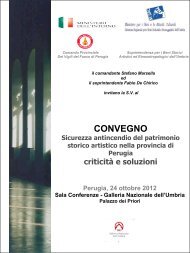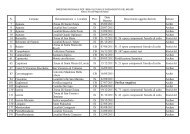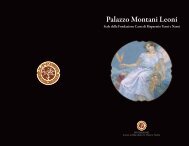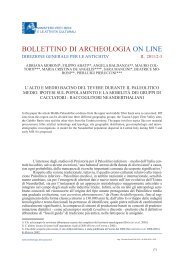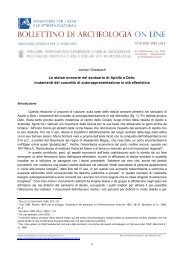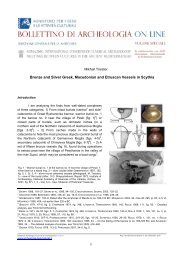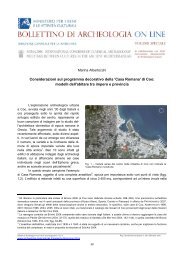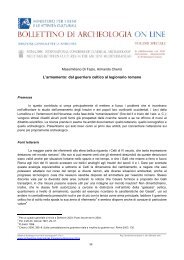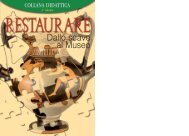Late Hellenistic Settlements in Hawrān (Southern Syria). Survival of ...
Late Hellenistic Settlements in Hawrān (Southern Syria). Survival of ...
Late Hellenistic Settlements in Hawrān (Southern Syria). Survival of ...
You also want an ePaper? Increase the reach of your titles
YUMPU automatically turns print PDFs into web optimized ePapers that Google loves.
J. Rohmer - <strong>Late</strong> <strong>Hellenistic</strong> <strong>Settlements</strong> <strong>in</strong> Hawrân (<strong>Southern</strong> <strong>Syria</strong>). <strong>Survival</strong> <strong>of</strong> Proto-historic Urbanism and Village Architecture <strong>in</strong> a Hellenized<br />
Context<br />
The <strong>Late</strong> <strong>Hellenistic</strong> period was one <strong>of</strong> great political <strong>in</strong>stability <strong>in</strong> Hawrân. In the southern Levant,<br />
the Seleucid authority was challenged by the emergence <strong>of</strong> powerful local states. Until the Roman conquest,<br />
the cities <strong>of</strong> southern Hawrân lived under the cont<strong>in</strong>uous threat <strong>of</strong> raids launched by these compet<strong>in</strong>g<br />
powers: Bosra was sacked by the Maccabees <strong>in</strong> 164/163 BC, together with other cities <strong>of</strong> the region, and<br />
Dion was violently conquered by Alexander Jannaeus at the beg<strong>in</strong>n<strong>in</strong>g <strong>of</strong> the 1 st c. BC 35 . The northern Jebel<br />
al-‘Arab was probably never annexed by these powers, save for a short period <strong>of</strong> Nabataean expansion<br />
towards the north, from 84 BC onwards. A passage <strong>of</strong> the Vita Isidori by Damascius, stat<strong>in</strong>g that “Bosra was<br />
fortified by the Arab k<strong>in</strong>gs aga<strong>in</strong>st its Dyonisian neighbours”, suggests that before the Roman conquest,<br />
Suweida had taken advantage <strong>of</strong> the political void to act as an autonomous local power 36 . The construction<br />
<strong>of</strong> the citadel on the fortified tell probably corresponds to these political developments. The contemporary<br />
settlement <strong>of</strong> Tell Jubeh, whatever its relationship with Suweida (allegiance, competition?), must probably be<br />
<strong>in</strong>terpreted <strong>in</strong> the same light. At any rate, the context <strong>of</strong> <strong>in</strong>stability and conflict which prevailed <strong>in</strong> the region<br />
from the mid-2 nd c. BC until the Roman conquest certa<strong>in</strong>ly accounts for the need to build heavy cont<strong>in</strong>uous<br />
fortifications as a prerequisite whenever a settlement was founded (Tell Jubeh). It may also expla<strong>in</strong> why the<br />
major cities <strong>of</strong> Hawrân (Dion, Bosra, Suweida) developed under the protection <strong>of</strong> their proto-historic<br />
fortifications, <strong>in</strong>stead <strong>of</strong> expand<strong>in</strong>g out <strong>of</strong> the tells.<br />
In the second half <strong>of</strong> the 1 st c. BC, <strong>in</strong> spite <strong>of</strong> the Roman conquest, the region was affected by<br />
another k<strong>in</strong>d <strong>of</strong> <strong>in</strong>stability. Josephus and Strabo describe Trachonitis as a nest <strong>of</strong> semi-nomadic bandits,<br />
liv<strong>in</strong>g <strong>in</strong> caves with their flocks and subsist<strong>in</strong>g ma<strong>in</strong>ly on robbery <strong>of</strong> the neighbour<strong>in</strong>g pla<strong>in</strong>s 37 . They report <strong>in</strong><br />
similar terms the compla<strong>in</strong>ts addressed to Augustus by the sedentary <strong>in</strong>habitants <strong>of</strong> the region aga<strong>in</strong>st these<br />
bandits, who took shelter <strong>in</strong> the rocky enclave <strong>of</strong> Trachonitis. This area was <strong>in</strong>deed an ideal refuge for<br />
bandits try<strong>in</strong>g to escape retaliation or repression. Its chaotic topology significantly h<strong>in</strong>ders visibility,<br />
circulation and orientation. Its “sub-basaltic corridors” (which fit quite well with Josephus’ and Strabo’s<br />
description <strong>of</strong> the bandits’ “dens”) are ideal hid<strong>in</strong>g places for clandest<strong>in</strong>e groups 38 . The present name <strong>of</strong> the<br />
area, Leja, predictably means “refuge” <strong>in</strong> Arabic. The <strong>in</strong>security favoured by these topographical specificities<br />
probably accounts for the existence <strong>of</strong> heavily fortified sites like Kreim aj-Janoûbi on the border <strong>of</strong><br />
Trachonitis.<br />
Anthropological clues<br />
Another explanatory factor for the layout <strong>of</strong> the sites is the nature <strong>of</strong> the populations <strong>in</strong>volved <strong>in</strong> the<br />
settlement process. In “desert cities” such as Petra or Palmyra, the dispersed mode <strong>of</strong> development has<br />
been generally <strong>in</strong>terpreted as the result <strong>of</strong> the progressive sedentarization <strong>of</strong> nomadic tribes 39 . The specific<br />
characters <strong>of</strong> the settlements under discussion may be the result <strong>of</strong> different anthropological conditions.<br />
The layout and the environment <strong>of</strong> the newly created settlements suggests that pastoralism played a<br />
prom<strong>in</strong>ent part <strong>in</strong> their economy. In Kreim aj-Janoûbi and Khirbet ‘Arish, the wide courtyards or enclosures<br />
associated with the domestic structures are probably to be related with sheep or goat breed<strong>in</strong>g. Both sites<br />
are located at a certa<strong>in</strong> distance (more than 1 km) from the nearest agricultural lands. The basaltic zone<br />
around Kreim aj-Janoûbi allows at best the practice <strong>of</strong> small-scale tree cultivation <strong>in</strong> micro-rifts. The<br />
environment <strong>of</strong> Khirbet ‘Arish is entirely rocky, without any agricultural potential, and the nearest agricultural<br />
lands have poor and stony soils. However, the area is marked by the presence <strong>of</strong> many large depressions<br />
which are filled with water <strong>in</strong> w<strong>in</strong>ter and <strong>in</strong> spr<strong>in</strong>g 40 . These depressions provide abundant dr<strong>in</strong>k<strong>in</strong>g water for<br />
herds. They were apparently used for this purpose until a recent period, s<strong>in</strong>ce many rema<strong>in</strong>s <strong>of</strong> Bedou<strong>in</strong><br />
camps are still visible today <strong>in</strong> the area. All this suggests that the economy <strong>of</strong> these settlements rested<br />
35<br />
See supra n. 8 and 13.<br />
36<br />
Photius, Bibliotheca, cod. 242, §196.<br />
37<br />
Josephus, AJ, 15.342–354; Strabo, Geography, 16.2.20.<br />
38<br />
VILLENEUVE 1985.<br />
39<br />
See supra n. 6.<br />
40<br />
See BRAEMER Forthcom<strong>in</strong>g for an analysis <strong>of</strong> this phenomenon.<br />
Bollett<strong>in</strong>o di Archeologia on l<strong>in</strong>e I 2010/ Volume speciale G / G5 / 2 Reg. Tribunale Roma 05.08.2010 n. 330 ISSN 2039 - 0076<br />
www.archeologia.beniculturali.it<br />
8



